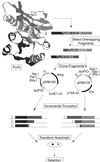Combinatorial protein engineering by incremental truncation
- PMID: 10097076
- PMCID: PMC22333
- DOI: 10.1073/pnas.96.7.3562
Combinatorial protein engineering by incremental truncation
Abstract
We have developed a combinatorial approach, using incremental truncation libraries of overlapping N- and C-terminal gene fragments, that examines all possible bisection points within a given region of an enzyme that will allow the conversion of a monomeric enzyme into its functional heterodimer. This general method for enzyme bisection will have broad applications in the engineering of new catalytic functions through domain swapping and chemical synthesis of modified peptide fragments and in the study of enzyme evolution and protein folding. We have tested this methodology on Escherichia coli glycinamide ribonucleotide formyltransferase (PurN) and, by genetic selection, identified PurN heterodimers capable of glycinamide ribonucleotide transformylation. Two were chosen for physical characterization and were found to be comparable to the wild-type PurN monomer in terms of stability to denaturation, activity, and binding of substrate and cofactor. Sequence analysis of 18 randomly chosen, active PurN heterodimers revealed that the breakpoints primarily clustered in loops near the surface of the enzyme, that the breaks could result in the deletion of highly conserved residues and, most surprisingly, that the active site could be bisected.
Figures




References
-
- Kato I, Anfinsen C B. J Biol Chem. 1969;244:1004–1007. - PubMed
-
- Ullmann A, Jacob F, Monod J. J Mol Biol. 1967;24:339–343. - PubMed
-
- Bertolaet B L, Knowles J R. Biochemistry. 1995;34:5736–5743. - PubMed
-
- Ladurner A G, Itzhaki L S, Gray G P, Fersht A R. J Mol Biol. 1997;273:317–329. - PubMed
-
- Tasayco M L, Carey J. Science. 1992;255:594–597. - PubMed
Publication types
MeSH terms
Substances
Grants and funding
LinkOut - more resources
Full Text Sources
Other Literature Sources

